Saints of the Day
 |
 |
 |
 |
 |
 |
 |
Humiliation of St. Joseph - December 23-25
- Part III -
“As Mary rested there, Joseph hurried with a skin which he had brought with him into the valley-meadow behind the hill, where there was a tiny brook. He fastened the skin with two pegs under the spring so that the water had to run into it, and then brought it back to the cave and offered it to Our Lady.”
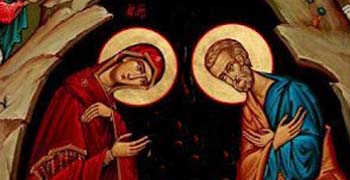
St. Joseph recites the Sabbath prayers with Our Lady
“As the Sabbath had now begun, he stood with the Blessed Virgin under the lamp reciting the Sabbath prayers with her, after which they ate their little meal in a spirit of great piety”
Saturday was the Sunday for the Jews. Sunday is the day of the Resurrection; Saturday is the last day of Creation. The Jews rested on Saturday. We, as Catholics, used to attend Mass and rest on Sunday – until the time of Paul VI.
“During Joseph's absence I saw for the first time the Blessed Virgin kneeling in prayer. She knelt on her couch, and then lay down on the coverlet on her to sleep.”
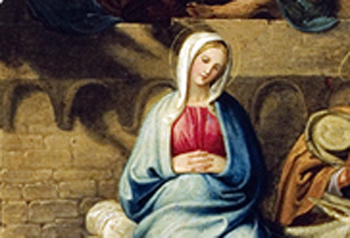
Our Lady, with a perfect peace & calm
“Her head rested on her arm, which lay on the pillow. Joseph did not come back till late. He was distressed and I think he wept. He prayed and then lay down meekly on his couch at the entrance of the cave.”
Since the couple was most chaste, the spouses slept apart from each other.
“The Blessed Virgin spent the Sabbath in the Cave of the Nativity in prayer and meditation and in great spiritual fervor. Joseph went out several times, probably to the Synagogue in Bethlehem. I saw them sharing the food that had been prepared the day before, and praying together.”
Now, the day of the 24th was almost over; midnight was coming and they were living their normal life: Our Lady was praying, resting, eating, and he went out to the city of Bethlehem to arrange some matters and participate in some ceremonies at the Synagogue.
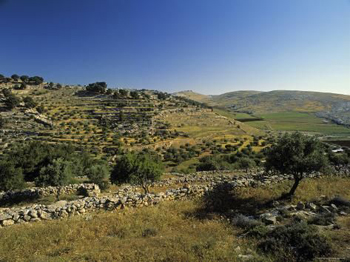
The Holy Couple made a pilgrimage in the valley
It was a kind of pilgrimage made on Saturday afternoon. He led her to this place reputed as holy.
“This grotto was roomier than the Cave of the Nativity, and Joseph had prepared a place for the Blessed Virgin to sit in it. The rest of the time they spent under a nearby tree in prayer and meditation until some time after the close of the Sabbath, when Joseph led Mary back to the Cave. For Mary had told him that on that Night at midnight would be the hour of the Child's Birth, for then the nine months since the Annunciation would be completed.”
We can imagine his joy and the natural way she informed him of his. Most probably she addressed him simply and in a completely natural voice, “Thou shouldst know, my spouse, that the Word of God incarnate in me will be born in just a few hours. According to the prophecies it will be in a cave.”
I imagine that his answer was also simple, “Ah! Yes.” And the two made their way back to the grotto, their thoughts entirely turned toward God. That is how I imagine the scene.
“Mary asked him to do all that was possible on his part so that they might show as much honor as they could to the Child promised by God and supernaturally conceived. She asked him, too, to join her in praying for the hard-hearted persons who had refused to give them shelter.”
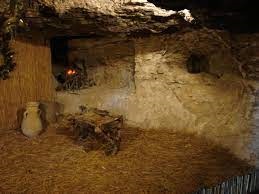
St Joseph prepares the cave
with as great a dignity as possible
“Joseph suggested to the Blessed Virgin that he should summon to her assistance some pious women whom he knew in Bethlehem to help her. She declined, however, saying that she needed no human help.”
She already knew that the Birth would occur in a miraculous way that no one would know. But notice the discrete way she said that she needed no assistance. St. Joseph did not question her further.
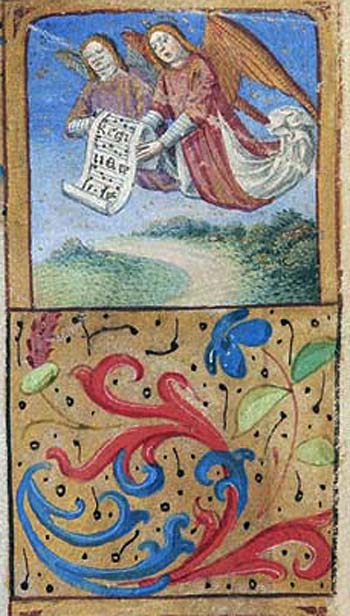
Everything was filled with the supernatural
If you wish, it was a Christmas Eve supper.
“He then completely divided off his sleeping place from the rest of the cave by surrounding it with posts and hanging on them mats that he had found in the cave. He fed the donkey, which was standing to the left of the entrance against the wall of the cave and tied it to a wall.”
He did those things with his thoughts fixed on in God, in continuous meditation. It was not as if he were distracted by those actions. This is how things are done: fulfilling his duty, but with his mind on the highest of thoughts. Anne Catherine Emmerick also pays attention to everything: even the comings and goings of the donkey are not overlooked by her.
This gives us a completely different idea of the contemplative spirit from what persons generally imagine. Many imagine contemplation as being out of reality, something that is somewhat frenetic. But here we find St. Joseph, serene and calm, facing the reality around him, but above all looking at an invisible supernatural reality, which is the most real reality.
“He filled the manger above the crib with rushes and fine grass or moss, and spread a covering over it which hung down over the edge.”
So, for the Son of God who would be born, there was only rushes, grass and moss and a quilt spread over them. She tells us that at Christmas the moss as well as all of nature became magnificent and resplendent. Since Our Lord said that “even Solomon in his glory was not arrayed like one of these lilies of the field,” we can ask if it there ever was or will be a more beautiful velvet than the moss upon which the Infant God laid. These are the contrasting miseries and grandeurs of divine things.
“On the Blessed Virgin telling him that her time was drawing near and recommending that he retire into his room and pray, Joseph hung up some more burning lamps in the cave.”
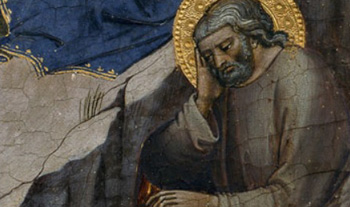
Joseph retires to the cave entrance
as midnight approaches
“Then he went out, as he had heard a noise coming from the entrance.”
Notice the height of his recollection, but also of his serious and profound balanced state of mind.
It is the description of such details that leads us to believe these revelations of Ven. Anne Catherine Emmerick, because a woman who imagines things would not describe things in this way. She would imagine theatrically sublime dialogues for which Verdi could compose an opera. This was not what Anne Catherine Emmerick did. Everything that she describes is serene and dignified.
“Here he found the young she-ass, who until now had been wandering about loose in the valley of the shepherds. She came joyfully running up and gamboled round him.”
It is poetic scene, the mule that becomes joyful.
“He tied it up under the shelter in front of the cave and strewed fodder before.”
Continued

Humiliation of Sr. Joseph - Part II
 | |
|
|
The texts of both the biographical data and the comments come from personal notes taken by Atila S. Guimarães from 1964 to 1995. Given the fact that the source is a personal notebook, it is possible that at times the biographic notes transcribed here will not rigorously follow the original text read by Prof. Plinio. The commentaries have also been adapted and translated for TIA’s site.


